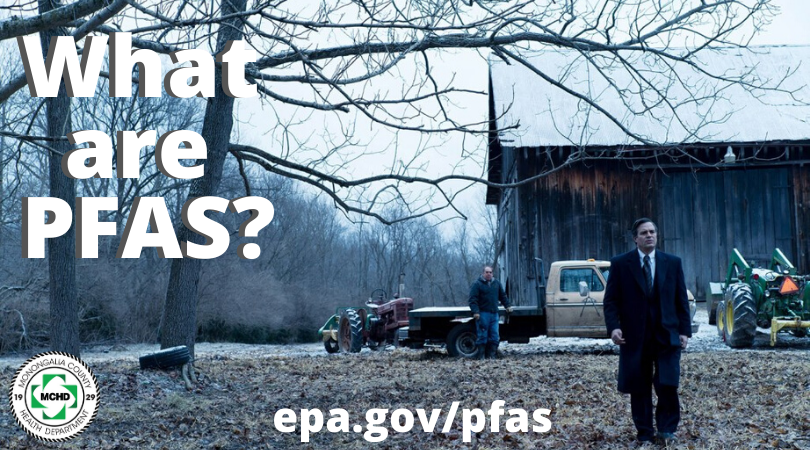“Dark Waters” hits close to home

Jan. 15, 2020
By Mary Wade Burnside
My boss, Dr. Lee B. Smith, executive director of Monongalia County Health Department and county health officer, often slips this line in when giving an overview of the different types of issues public health workers address. These actions sometimes occur without the public’s awareness of behind-the-scenes work that takes place to keep them safe.
And to be sure, Americans are lucky to be able to drink tap water without having to worry much about coming down with illnesses such as cholera, typhoid and dysentery.
The Centers for Disease Control and Prevention maintains the Waterborne Disease and Outbreak Surveillance System, which investigates waterborne disease outbreaks in the United States and its territories.
Unfortunately, keeping water pure has gotten more difficult in recent years.
One newer threat has come to light in the past decade or so: per- and polyfluoroalkyl substances, also known as PFAS, a type of synthetic chemicals found in many consumer products like cookware, food packaging, stain repellents and firefighting foam. PFAS has seeped into water systems but also can be found adjacent to several packaged grocery items such as candy and fast food wrappers.
A captivating and absorbing new film, “Dark Waters,” has been in theaters for a couple of weeks now. It didn’t receive any Oscar nominations on Monday but it could be one of the most important movies you see. It should be of interest to just about everyone, because, according to information provided at the end, PFAS can be found in about 99% of all humans.
It should especially intrigue West Virginians, however, because the key locale of the film is the Parkersburg, West Virginia area, home to the former DuPont chemical plant that is the antagonist in “Dark Waters.”
The type of chemical used at this plant was perfluorooctanoic acid, or PFOA, a type of PFAS.
But when the movie’s timeline begins, in the late 1990s, actor Mark Ruffalo, playing Cincinnati attorney Robert Bilott, can’t find any reference to PFOA on the rudimentary internet that existed at the time. He finally tracks down an industry chemist to explain it to him. As depicted in the film, this was the beginning of PFAS becoming known to the public. A settlement wasn’t reached until early 2017.
Bilott, an environmental attorney who usually represented major industries, got pulled into the case by an acquaintance of his grandmother’s in Parkersburg. The man’s cows were dying mysteriously. When Bilott examined the situation more thoroughly, he also found people in the area with black, rotting teeth and women who had worked on the line of one of the company’s more popular products, Teflon, bearing babies with birth defects.
Dr. Smith learned about PFAS when he attended the Executive Leaders Program at the Naval Postgraduate Academy in Monterey, California. Upon his return, he sent Jamie Moore, MCHD’s Threat Preparedness coordinator, and Richard McCord, an MCHD Environmental Health registered sanitarian, to a conference in Pittsburgh to get more information.
Here is what they found out:
• PFAS have been manufactured and used in a variety of industries around the globe since the 1940s. U.S. manufacturers voluntarily phased out PFOA and PFOS, two specific PFAS chemicals, but they still import them from other countries. PFAS also have been replaced by GenX chemicals, the safety of which have been questioned.
• The Environmental Protection Agency (EPA) has developed additional toxicity values and analytical methods for PFAS and non-drinking water media as well as treatment options for PFAS in drinking water.
• PFAS don’t break down over time, so they build up in the environment and our bodies.
• Health effects caused by PFAS can cause reproductive and developmental, liver, kidney and immunological effects in laboratory animals. In humans, the chemicals have been connected to higher cholesterol, infant birth weights, adverse effects on the immune system, cancer (PFOA) and thyroid hormone effects (PFOS).
So how can you keep safe from PFAS? The CDC has published a list at atsdr.cdc.gov/pfas/pfas-exposure.html. You can also get more information from the EPA.
Also, Delegate Evan Hansen of Monongalia County, a water research scientist, announced in December that he will introduce a water safety bill during the upcoming state legislative session that would, among other things, identify where PFAS are being used and discharged so they can be regulated.
And finally, see “Dark Waters,” which will be available to purchase on DVD and Blu-ray in early March.
It’s a great introduction into the topic of PFAS. It’s also an enthralling movie that hits very close to home, using the song “Take Me Home, Country Roads” ironically rather than in victory.
Mary Wade Burnside is the public information officer at Monongalia County Health Department.